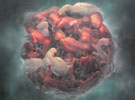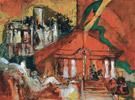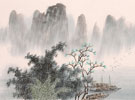小结
里希特在绘画创作中对摄影的借用,看似是对摄影再现方式的主动模仿,实则是对绘画精神价值的坚持。他在言论中一再强调自己的中立态度或“无风格”,既源于他那一代人的处境造成的刺激,和德国民族历史造就的特点,也是他自己思考方式和所关注的问题决定的。丹托敏锐地指出:“纳粹后的第一代艺术家,要在保持德国特征的同时重新衔接现代主义。此外他们还要处理像一道致命伤般将祖国一分为二的严酷冷战,这是彻底的政治划分。里希特就是所有这些局面的产物。但是就像沃霍尔——他在很多方面都与之相似——他发展出一种自我保护的冷酷感,使他和观者仿佛能够在一定距离之外体验历史现实。”[23]
然而,他的作品从来都没有冷酷到让人失望,而是一再提示着以这个时代的面目呈现出来的人类永恒的问题。历史永远是模糊的,用模糊的方式来再现它反而更加可信。邵亦杨认为,“里希特所提出的问题不仅仅属于他那个时代,他那个民族,而且也属于所有人。艺术家所制造的模糊感告诉我们:画面上的一切是关于记忆的,它已经属于历史了,但有一种忧虑、一种恐惧感却依然存在着,萦绕着画面,也萦绕在所有观看者的心头挥之不去。”[24]正是他所提出的这些超越时空范围的问题,支撑着他的艺术穿过文化的隔阂,获得更广泛的认同,产生更宽阔的感染力。
在关心历史的同时,里希特还非常关心艺术史,始终放不下对西方再现性绘画的历史和精神的追问,他确实有一种20世纪艺术家中少见的古典主义情结。与其说他的绘画中最重要的问题是模仿摄影,不妨说他的核心问题是:在摄影已经逐渐主导了日常视觉方式的时代,绘画如何再现历史现实。他成功地实现了一种独特的视觉转换方式,实现了那个时代绘画再现方式的一种可能性,主动续写了西方绘画的历史。
注释
[1]见【美】戴维•萨默斯《再现》,载《新美术》2006年第6期,总第27卷,P16
[2]Roger Scruton, “Photography and Representation”, Arguing about Art, edited by Alex Neill and Aaron Ridley, second edition, Routledge, London, 2002. P198
[3]“Notes, 1964-1965”, Gerhard Richter Text: Writings, Interviews and Letters 1961-2007, edited by Dietmar Elger and Hans Ulrich Obrist, Thame & Hudson Ltd, London, 2009. P32
[4]E. H. Gombrich, Art and Illusion, sixth edition, Phaidon Press Inc, London, 2002. P12
[5]“Interview with Rolf Schon,1972”, Gerhard Richter Text: Writings, Interviews and Letters 1961-2007, edited by Dietmar Elger and Hans Ulrich Obrist, Thame & Hudson Ltd, London, 2009. P59
[6]Robert Storr, Gerhard Richter : Doults and Belief in Painting, The Museum of Modern Art, New York, 2003. P100
[7]Benjamin H. D. Buchloh, “Divided Memory and Post-Traditional Identity: Gerhard Richter’s Work of Mourning,” October 75 (winter 1996). P73
[8]Robert Storr, Gerhard Richter : Doults and Belief in Painting, The Museum of Modern Art, New York, 2003. P103
[9]《技术复制时代的艺术作品》【德】瓦尔特•本雅明著,胡不适译,浙江文艺出版社,2005年第一版P41
[10]Hilde Van Gelder, “The Present-day Scholar: an (im)possible representation?”, Image and Narative, Issue 10, March 2005.
[11]John Cage, “Lecture on Nothing,” Exhibition of The Anarchy of Silence: John Cage and Experimental Art. Barcelona: Museu d’Art Contemporani de Barcelona, 2009.
[12]Robert Storr, Gerhard Richter : Doults and Belief in Painting, The Museum of Modern Art, New York, 2003. P89
[13]Robert Storr, Gerhard Richter : Doults and Belief in Painting, The Museum of Modern Art, New York, 2003.P104
[14]“Interview with Jonas Storsve, 1991”, Gerhard Richter Text: Writings, Interviews and Letters 1961-2007, edited by Dietmar Elger and Hans Ulrich Obrist, Thame & Hudson Ltd, London, 2009. P272
[15]Helmut Friedel: “Gerhard Richter’s Palette Paintings”, Gerhard Richter: Red, Yellow or Blue, Prestel Verlag, New York, 2007. P18
[16]Robert Storr, Gerhard Richter : Doults and Belief in Painting, The Museum of Modern Art, New York, 2003.P174
[17]【英】爱德华•露西-史密斯著,殷企平等译《艺术词典》,三联书店,2005.5,P102
[18]Robert Storr, Gerhard Richter : Doults and Belief in Painting, The Museum of Modern Art, New York, 2003. P52, Note 65: Roland Barthes, Camera Lucida: Reflections on Photography, trans. Richard Howard (New York: Hill & Wang, 1981): 15
[19]见王志亮《格哈德•里希特给我们带来了什么?》,载《美术观察》2008. 01
[20]“Notes for a press conference, November-December 1988’, Gerhard Richter Text: Writings, Interviews and Letters 1961-2007, edited by Dietmar Elger and Hans Ulrich Obrist, Thame & Hudson Ltd, London, 2009. P202
[21]Benjamin H. D. Buchloh, “A Note on Gerhard Richter’s October 18, 1977”, Theory in Contemporary Art since 1985, edited by Zoya Kocur and Simon Leung, Blackwell Publishing Ltd, 2005. P290, Note 4
[22]Benjamin H. D. Buchloh, “A Note on Gerhard Richter’s October 18, 1977”, Theory in Contemporary Art since 1985, edited by Zoya Kocur and Simon Leung, Blackwell Publishing Ltd, 2005. P283
[23]Arthur C. Danto, “History in a Blur”, The Nation, May 13, 2002.
[24]见邵亦杨《从绘画到影像——数码时代的三个片段》,载《文艺研究》2009.6




